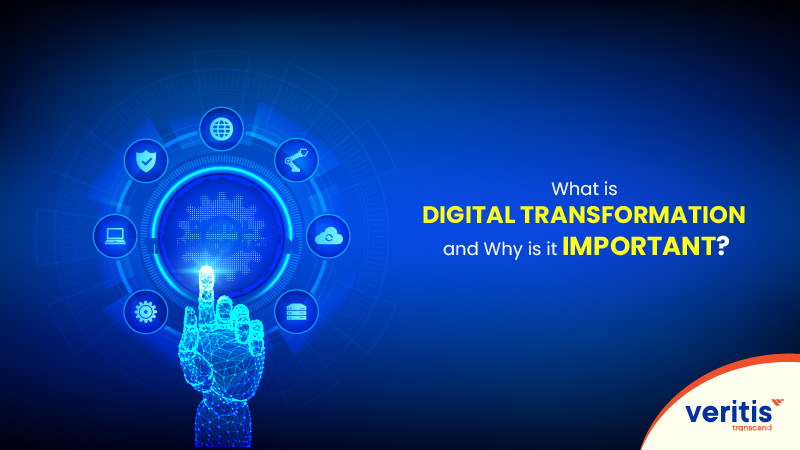
Digital transformation is no longer optional; it’s a strategic imperative. Global spending on digital transformation technologies and services is forecasted to reach $2.8 trillion in 2024, up from $1.3 trillion in 2022. More than 70% of U.S. companies already have digital transformation consulting services, accounting for 35.8% of this expenditure.
The question of how to digitally convert established businesses is what matters most in the current business context, rather than whether they must. Getting stakeholder buy in, holding them accountable, overcoming organizational silos, and removing procedural barriers are typically significant obstacles to developing digital capabilities. However, teams that can collaborate effectively across business units, with transformation partners, and within a broader partner ecosystem will succeed.
Digital transformation is no longer optional; it’s a strategic imperative. Global spending on digital transformation technologies and services is forecasted to reach $3.9 trillion by 2027, with the United States accounting for over $1 trillion in 2025. More than 70% of U.S. companies already have digital transformation consulting services, accounting for 35.8% of this expenditure.
This surge demonstrates the deep integration of digital transformation initiatives into how industries plan, operate, and expand. While more than 70% of U.S. organizations already engage in digital transformation consulting, the real question today isn’t whether businesses should transform; it’s how they should do so. The factors driving digital transformation include stakeholder buy in, accountability, breaking down organizational silos, and removing procedural barriers. These are often the biggest hurdles to building digital capabilities. However, organizations that foster cross functional collaboration, both internally and with transformation partners, are more likely to succeed.
As digital transformation strategies reshape industries, many companies are launching large scale digital transformation projects to stay competitive. According to a recent McKinsey Global Survey, over 80% of respondents said their firms had undertaken such initiatives in the past five years. Yet, success remains elusive: only 35% of digital transformation efforts are successful, and fewer than one third of organizational transformations lead to sustained performance improvements.
This shift is evident in four key areas:
- Telecommuting: Remote work is now mainstream across industries, redefining workforce models.
- On demand Services: Online delivery has become the norm, requiring businesses to adapt rapidly.
- Virtual Events: In person meetings and events have given way to platforms like WebEx and Zoom.
- Cloud: Cloud based operations are now foundational; it’s hard to imagine a non cloud world.
All these digital transformation trends underscore why digital transformation services are more critical than ever. So, what are your plans for digital transformation?
Digitally Transform Your Business
What is Digital Transformation, and Why is it Important?

Digital transformation is about rethinking how a business works. It’s the process of utilizing digital tools to enhance how teams operate, make decisions, and deliver value. But it’s not about technology, it’s about people, leadership, and culture.
The purpose behind any digital transformation initiative is to make the organization more agile, more productive, and better aligned with the way the world works today. That means updating systems, yes, but also updating how teams think, collaborate, and lead.
Fundamental transformation takes time. It’s not a quick fix. It’s a series of digital transformation projects that evolve as your people, processes, and tools grow. For that to work, leaders need to build trust, offer clarity, and choose technology partners who understand how to bring people along for the journey.
Most of the investment goes into the right tools, cloud platforms, training, and flexible IT environments. The cloud plays a central role in this process. It connects systems, speeds up operations, and allows teams the flexibility they need to respond to customers and stakeholders.
Many companies begin by utilizing tools like CRM systems to stay connected. However, the fundamental shift occurs when you assemble a team that’s prepared to lead your digital transformation strategy, people who are confident in using new tools and open to new ways of working.
For executives, this is not about upgrading software. It’s about leading change. Over 80% of Fortune 500 organizations are actively prioritizing digital transformation initiatives to deepen customer engagement, strengthen internal capabilities, and maintain their competitive edge.
U.S. companies are leading the way, driving over 35% of the global investment in transformation. That’s not just a statistic, it’s a signal. The companies that move with clarity and purpose are the ones shaping the future.
And while transformation isn’t easy, it’s worth it. It’s not just about adopting technology, it’s about building a company that’s ready for what’s next.
Useful link: How Digital Transformation in Finance and Accounting is Reshaping Business Operations?
What Are the Tangible Business Benefits of Digital Transformation?

Digital transformation delivers results. Not someday, now. The companies that commit to it are experiencing real gains across revenue, efficiency, customer experience, and decision making.
The following are the principal benefits of the digital transformation journey:
1) Revenue Acceleration
Revenue growth is one of the most visible outcomes. Businesses that invest in digital transformation initiatives are growing up to 35% faster than their competitors. They’re utilizing data, automation, and digital platforms to reach customers more effectively and respond more quickly to market shifts.
2) Operational Efficiency
Efficiency improves across the board. Cloud adoption, process automation, and integrated systems are helping teams work smarter. Many organizations report a 20 30% increase in operational speed and accuracy. These aren’t isolated successes; they’re the result of well planned digital transformation strategies.
3) Cost Optimization
Smart transformation reduces waste. Companies that migrate to cloud first models and automate routine workflows are reporting IT cost savings of 15–20%. These savings are being reinvested into innovation, talent, and customer experience.
4) Customer Retention and Loyalty
Digital first businesses are witnessing a 35% increase in customer satisfaction and up to 18% higher retention rates. Why? Because they’re meeting customers where they are, on mobile, on demand, and on their terms.
5) Employee Productivity
Empowered teams perform better. With the right tools and training, companies are experiencing a 30% boost in employee productivity. This is not about software, it’s about building a culture that supports change and rewards initiative.
6) Smarter Decision Making
Data is only valuable when it drives action. Companies that embed analytics into their digital transformation projects are making faster, more informed decisions and witnessing 20% higher ROI on strategic initiatives.
7) Industry Specific Impact
- Retail: Over 50% of sales now come through digital channels.
- Healthcare: Telehealth adoption has increased by 30%, enhancing access and lowering costs.
- Manufacturing: Automation is streamlining 35% of workflows.
- Finance: One in four IT dollars is now spent on digital transformation services.
Useful link: 5G Use Cases Paving the Way for Technological Advancements
What Are the Top 10 Factors That Drive a Successful Digital Transformation Initiative?

Here are 10 key factors driving digital transformation that you need to consider when planning and executing digital transformation initiatives and digital transformation projects as part of your long term digital transformation strategies.
1) Customer oriented Approach
This is the fundamental basis for success in any digital transformation initiative, requiring a shift in mindset from a product focused to a customer oriented approach. Every deliverable in your digital transformation projects should aim to satisfy customers and simplify their lives.
2) Culture and Change
Drive in a vision backed by a collaborative mindset and influential thought leadership. Break down the siloes and bring change management built on cultural transformation. Align the change management efforts with modern, dynamic business environments to support sustainable digital transformation strategies.
3) Thought Leadership
Thought leadership should begin at the top level, and leaders should emerge at all levels, backed by a strong vision aligned to business goals. This involves someone who is technically proficient and has a broad understanding of the industry, customers, data science, machine learning, artificial intelligence, and the cloud. Skills in team management, client relations, and implementing digital transformation initiatives are crucial.
4) Technology Decision Making
This is key to the success of digital transformation initiatives. All responsible stakeholders should be heard when making technology decisions. Review front and back end systems to ensure a seamless, integrated, and native customer experience and, ultimately, a positive employee experience. Leverage technology to enhance credibility and meet the growing expectations of our clients. Ensure your messages and content are platform proof to prevent algorithm changes from affecting user experiences.
5) Effective Integration
With all data systems integrated into the mainstream process, a well streamlined data strategy is essential for overcoming digital transformation challenges and making digital transformation projects successful.
6) Internal Experience
Internal employees should act as customers in deciding the experience factor for any digital solution. Gathering the proper feedback helps meet customer expectations and aligns with broader digital transformation strategies.
7) Enhanced Supply Chain
Digital transformation initiatives can make your supply chain faster, more reliable, and more seamless than ever. Explore ways to digitize various aspects of the supply chain, from manufacturing to fulfillment and delivery.
8) Data Security
As you adopt new processes, security is a foremost concern that poses a severe threat to confidential organizational or user data. This is why digital transformation strategies must incorporate robust regulatory and privacy policies to ensure the safety of data.
9) Service Delivery
Change the way you deliver products and services. Promote a delivery mechanism backed by innovation and efficiency to strengthen your digital transformation projects.
10) Personalization
Leverage the potential of digital solutions to ensure a personalized product experience. Use AI powered solutions to understand customer behavior and deliver the desired results, which is a key factor in driving successful digital transformation initiatives.
Case Study: A Holistic Approach to Digital Transformation in Healthcare
Objective:
Transform healthcare operations by integrating digital technologies to enhance patient care, streamline processes, and ensure compliance.
Challenge:
Fragmented legacy systems and inefficient data management hindered real time decision making and patient care efficiency.
Solution:
Veritis implemented a holistic digital transformation strategy, integrating cloud solutions, automation, and advanced data analytics to modernize healthcare infrastructure and improve operational workflows.
Outcome:
- Improved patient outcomes through real time insights
- Enhanced operational efficiency with automated processes
- Scalable infrastructure supporting future growth and innovation
- Impact:
The healthcare provider successfully adopted a data driven, scalable digital ecosystem, improving patient care quality and operational agility.
Read the Full Case Study: A Holistic Approach to Digital Transformation in Healthcare
Capping it Off
Digital transformation is not about adopting new technologies; it’s about reimagining business models to stay competitive. By focusing on customer centric digital transformation strategies, fostering a supportive culture, and making informed technology decisions, organizations can navigate the complexities of digital transformation initiatives and achieve sustainable growth. This approach can help businesses achieve their objectives, expand into new areas, become more agile, increase productivity and profitability, and retain and motivate their workforce.
Beyond new technologies, the success of digital transformation projects depends on the support of top level executives, a shift in organizational culture, and employee buy in. A digital transformation company can play a key role in guiding businesses through these essential changes, ensuring alignment across all aspects of the transformation. These ten factors driving digital transformation strengthen your efforts, paving the way for new age business continuity and the next wave of business delivery.
These are just a few examples of digital transformation strategies that can help your business or corporation succeed in the digital age. Please contact Veritis, the Stevie Awards winner, if you have any additional queries. We will respond to your particular requirements.